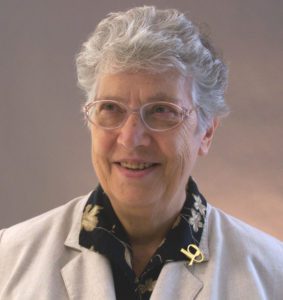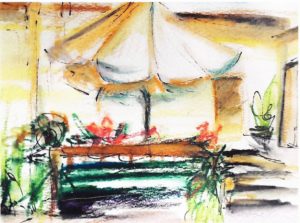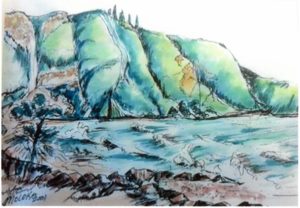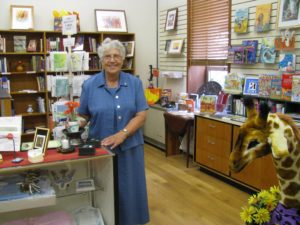
Sr. Jeanne: What attracted you to the Dominican Sisters of Sparkill community?
Sr. Ann: I grew up in the Bronx and was fortunate to be taught by the Sisters all through grade school at St. John Chrysostom, and then again at Aquinas High School, which opened up a wide world of friendship, community, and art to me. Sister Padraic McGrath was very influential and supportive. She invited us to be active participants in all the school activities, especially the plays.
Another Sister, Elizabeth Marie McCarthy, was truly committed to the fine and performing arts. We called her “Mighty Mouse” (not to her face, of course) and she would fearlessly get up on tall ladders and paint scenery for the plays. I remember Margie O’Doherty and I were assigned to design sets of dolls for Babes in Toyland, 15 feet high by 3.5 feet wide! It was fun and we formed great friendships. As our time in high school was concluding, a few of us got together and entered the convent. Those who entered then would know me as Sister Anton (after my father’s middle name).
Sr. Jeanne: So, art has been an important theme in your life?

Sr. Ann: Yes, and I really didn’t fully discover until I was 60 years old how much art was part of the fabric of my life. I enjoyed painting and later, when I did drafting work, I really liked it. I think it was always in my blood. My birth mother died when I was 4 years old, so it was not until many years later when I visited family in Austria, that I learned how my mother loved to sew needlepoint and how several cousins went into Engineering. Very interesting. Before emigrating to the United States, my mother traveled back-and-forth to New York to also help in a bakery that her sisters ran on 86th Street on the upper east side of Manhattan.
Sr. Jeanne: You were a good cook and baker, too?
Sr. Ann: Well, after studying at St. Thomas Aquinas College, before our Final Vows in 1956, to my surprise, six of us were sent to study at the College of Misericordia in Dallas, PA. At that time, Albertus Magnus High School in Bardonia, NY, was being built and I went to learn how to teach Home Economics, which was considered an important life skill at that time. Once I arrived at Albertus, because it was a new school, I was told to also furnish it. So, I used the lessons I learned at Dallas to select furniture and equipment. The classes were called, “Foods and Nutrition” and “Textiles.” It is remarkable that I am still in touch with so many of the girls from this class who even made their own wedding gowns later and dresses for others.
Sr. Jeanne: You seem to be a great connector with alumni/ae. How did that happen?
Sr. Ann: I don’t know, but I was interested in teaching and my motto was basically, ‘All things are possible with God’s help.’ So, although in the very beginning of my time at Albertus I taught 5 classes of Latin and I had only studied Latin in high school, I thought to myself, this is going to be interesting. But I prayed and prepared hard, and we got through it. However, when Sister Gerry McGinn came the second year to teach Latin, I pleaded with her not to fail them because any of their weakness was probably my fault. Thankfully she was merciful.
Sr. Jeanne: So, you had been sent to study Home Economics but taught Latin?
Sr. Ann: That’s the way things were then. I taught Latin and Religion. But the interesting part is that Sister Adele Myers and Sister Loretta Butler were at the school as the art teachers. And after a year, Sister Adele received a scholarship to study at Villa Schifanoia in Florence that was administered by the Sinsinawa Dominican Sisters of River Forest, Illinois. The following year, Sister Loretta also went to Villa Schifanoia. And then it was my turn to teach art. I learned the basics from Loretta and Adele at that time. They were my good teachers all through the years in art, and I felt like I was the carrier of their bag of tricks. Truthfully, I learned a lot from them, and I was successful because they were good teachers. And that was a beautiful thing.
I especially enjoyed teaching the new drafting course at Albertus. That is when the Engineering part of my epidermis began to

emerge because I could see different things. It was a stereotypical time when boys usually took drafting and girls took Home Economics—except when the boys came to Home Economics for emergency mending or when they were hungry after Track.
After 16 years at Albertus, wanting to be closer to my mother who had suffered an accident, I went down to Monsignor Scanlan High School in the Bronx and taught drafting there. I followed the cigar-smoking Marist Brother, Gerard. This was an adjustment for the boys that a Sister was teaching mechanical drawing. The said, "No way!", but they soon learned. After a while it was a good, very good class. Soon, even some girls came and wanted to take mechanical drawing.
Sr. Jeanne: Times were changing.
Sr. Ann: Yes, the times were changing. And I know that two of the girls went on to Spain to carry out Engineering. Quite a few of the boys went on to live successful careers. And I know that Sean Crosby went on to paint ceilings in Europe and internationally. He had Elizabeth Marie McCarthy for painting.
It was very exciting that Elizabeth, my teacher at Aquinas high school was now a colleague and I still learned from her. I have paint brushes from her for more than 50 years, and she had them before that for years. They look like they just came out of a new box because she had showed me how to take care of them.
Sr. Jeanne: I don’t know much about mechanical drawing. It sounds very interesting.
Sr. Ann: It is, and then it helped when our own chapel was being built here in Sparkill. At that time, I was still working on the Heritage Room with Sisters Adele and Elizabeth Slenker, and we transformed a meeting room into the beautiful Heritage Room.

Sr. Jeanne: And then you got involved with the DIA (Dominicans Institute of the Arts)? And that means a lot to you.
Sr. Ann: Yes! And now I don’t go as much. But it gave me an opportunity to travel to all the Dominican communities in the United States to see what they had. I made a lot of connections. It was beautiful. I always thought that that might be a way to connect before we talked about intercommunity. That if we sent Sisters to different communities for a month or so and had an exchange all that we would learn from each other.
Sr. Jeanne: That’s sort of what I did during my second, non-canonical novitiate year – cooking and baking at the Sinsinawa Mound and I loved it!
Sr. Ann: And the Mound is a beautiful place. The first time I went there I saw the amazing statues of St. Dominic and St. Catherine by our own Sister Rose Marie Morris. I had connected with Rose Marie earlier by going out to St. Louis to see her works because I knew she had taught high school and she also taught drafting. And I came back thinking that I was still in kindergarten.
Sr. Jeanne: It’s good that you went because she died so young.
Sr. Ann: It was beautiful to see what she was able to do with the students, but also her artwork was truly inspiring. She helped me with many different things. And later, it came to be that I became procurator of her artwork at the congregation's Gift Shop. I think she would have liked that.
I ran the Shop for 18 years after my sabbatical from Msgr. Scanlan High School in the Bronx where I taught art and drafting and I was

alumni director. Scanlan had 16,000 alumni and classes graduated with 200 or 300 students at that time. One of my memories is when we commemorated the first Earth Day where the kids painted on large rolls of paper that we hung out the windows near the Hutchinson River Parkway. The boys who got in trouble enjoyed that. I taught mostly boys, and if there were boys in trouble they would say, “Give them to Sister Ann.” To me they were not troublemakers, they were art works in progress.
Now, for fun, I like to go around and visit our infirmary sisters and try to bring a cookie or some candy and watch as their eyes brighten and smiles spread, revealing beautiful portraits of Dominican life.
